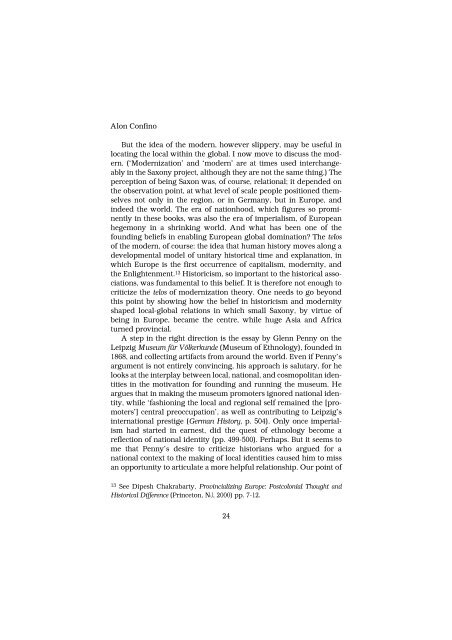Download - German Historical Institute London
Download - German Historical Institute London
Download - German Historical Institute London
You also want an ePaper? Increase the reach of your titles
YUMPU automatically turns print PDFs into web optimized ePapers that Google loves.
Alon Confino<br />
But the idea of the modern, however slippery, may be useful in<br />
locating the local within the global. I now move to discuss the modern.<br />
(‘Modernization’ and ‘modern’ are at times used interchangeably<br />
in the Saxony project, although they are not the same thing.) The<br />
perception of being Saxon was, of course, relational; it depended on<br />
the observation point, at what level of scale people positioned themselves<br />
not only in the region, or in <strong>German</strong>y, but in Europe, and<br />
indeed the world. The era of nationhood, which figures so prominently<br />
in these books, was also the era of imperialism, of European<br />
hegemony in a shrinking world. And what has been one of the<br />
founding beliefs in enabling European global domination? The telos<br />
of the modern, of course: the idea that human history moves along a<br />
developmental model of unitary historical time and explanation, in<br />
which Europe is the first occurrence of capitalism, modernity, and<br />
the Enlightenment. 13 Historicism, so important to the historical associations,<br />
was fundamental to this belief. It is therefore not enough to<br />
criticize the telos of modernization theory. One needs to go beyond<br />
this point by showing how the belief in historicism and modernity<br />
shaped local-global relations in which small Saxony, by virtue of<br />
being in Europe, became the centre, while huge Asia and Africa<br />
turned provincial.<br />
A step in the right direction is the essay by Glenn Penny on the<br />
Leipzig Museum für Völkerkunde (Museum of Ethnology), founded in<br />
1868, and collecting artifacts from around the world. Even if Penny’s<br />
argument is not entirely convincing, his approach is salutary, for he<br />
looks at the interplay between local, national, and cosmopolitan identities<br />
in the motivation for founding and running the museum. He<br />
argues that in making the museum promoters ignored national identity,<br />
while ‘fashioning the local and regional self remained the [promoters’]<br />
central preoccupation’, as well as contributing to Leipzig’s<br />
international prestige (<strong>German</strong> History, p. 504). Only once imperialism<br />
had started in earnest, did the quest of ethnology become a<br />
reflection of national identity (pp. 499-500). Perhaps. But it seems to<br />
me that Penny’s desire to criticize historians who argued for a<br />
national context to the making of local identities caused him to miss<br />
an opportunity to articulate a more helpful relationship. Our point of<br />
13 See Dipesh Chakrabarty, Provincializing Europe: Postcolonial Thought and<br />
<strong>Historical</strong> Difference (Princeton, NJ, 2000) pp. 7-12.<br />
24













